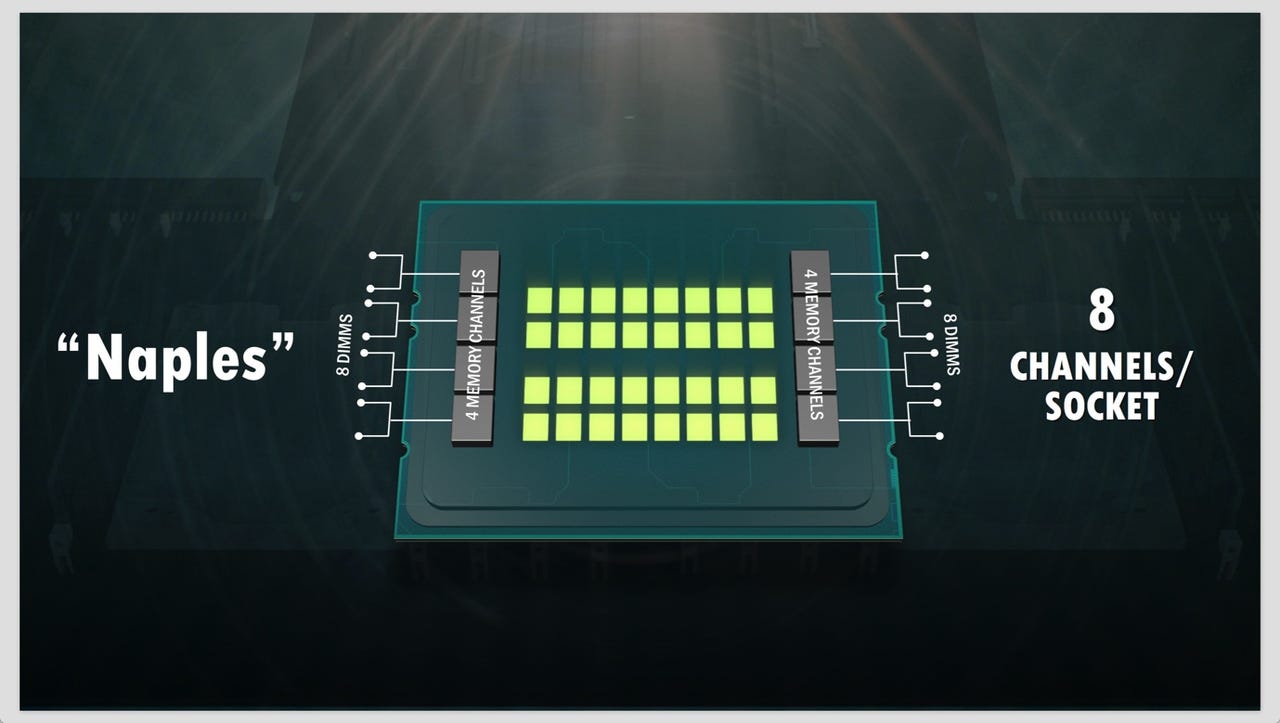AMD prepares for a datacenter comeback with 'Naples'


After dropping its high-end Ryzen desktop processors last week, AMD is taking aim at Intel once again -- this time in the datacenter with Naples.
Must read: Learn to become a Google Chrome power user
Naples is AMD's codename for its new 32-core System-on-Chip (SoC) silicon designed for the server market, and the supplied benchmarks suggest that Intel is once again on the back foot.
Naples highlights:
- A highly scalable, 32-core System-on-Chip design, with support for two high-performance threads per core
- Industry-leading memory bandwidth, with 8-channels of memory per Naples device. In a 2-socket server, support for up to 32 DIMMS of DDR4 on 16 memory channels, delivering up to 4 terabytes of total memory capacity
- The processor is a complete SoC with fully integrated, high-speed I/O supporting 128 lanes of PCIe 34, negating the need for a separate chip-set
- A highly-optimized cache structure for high-performance, energy efficient compute
- AMD Infinity Fabric coherent interconnect for two Naples CPUs in a 2-socket system
- Dedicated security hardware
AMD 'Naples' server processors
The chips, based on AMD's Zen microarchitecture, are designed to bring a more balanced architecture to the datacenter designed to handle modern workloads.
It has been designed to go head-to-head against Intel's fastest two-socket server offering, the Xeon E5-2699A V4 -- a $5,000, 22-core 14-nanometer chip based on the Broadwell microarchitecture.
AMD Naples
AMD's plan is to bring more memory capacity, more cores, more bandwidth, and more I/O to the server than Intel's top chip can muster.
AMD Naples
So, how does Naples perform against the Xeon E5-2699A V4?
Benchmarks supplied by AMD indicate that even when the dual Naples chips are restricted to only 44 cores (the same as a dual-Xeon E5-2699A V4 server) and the memory speed locked to 1866MHz, AMD's silicon can blow through ten iterations of a seismic analysis consisting of one billion samples in a little over half the time of the Intel chip (18 seconds compared to 35 seconds).
When the full power of the dual Naples processors is unleashed (all 64 cores, and memory speeds craned to 2400MHz), the AMD chips are two and a half times faster (14 seconds compared to 35 seconds).
But it's when the dataset is increased to four billion samples that the true scope of the Naples platform really shines through. Thanks to its increased memory capacity (Naples max memory capacity is 2.048 TB/processor, while the Intel Xeon E5-2699A v4 has a max memory capacity of only 1.54TB/processor), the AMD chip could chew through this workload in under a minute, while the Intel system had insufficient memory to load the dataset.
According to AMD, Naples will not be offered in any configuration greater than dual socket.
When Naples is combined with AMD's high-performance Radeon Instinct machine learning accelerators, full bandwidth is available to the accelerator cards, and four cards combined with the new Naples silicon is equivalent, according to AMD, to the computing power of one human brain.
AMD Naples and Radeon Instinct
"Today marks the first major milestone in AMD re-asserting its position as an innovator in the datacenter and returning choice to customers in high-performance server CPUs," said Forrest Norrod, senior vice president and general manager, Enterprise, Embedded and Semi-Custom business unit, AMD. "Naples represents a completely new approach to supporting the massive processing requirements of the modern datacenter. This groundbreaking system-on-chip delivers the unique high-performance features required to address highly virtualized environments, massive data sets and new, emerging workloads."
Naples hardware will be available Q2 2017, with volume availability building in the second half of the year through OEM and channel partners. No pricing has yet to be released.
AMD Ryzen: Everything you need to know
See also:
- Amazon could hammer the final nail into the iPad's coffin
- Samsung Galaxy S8 and S8 Plus tech specs
- iPhones are much more unreliable than Android devices, claims report
- Kingston's 2TB 'world's highest capacity USB flash drive' costs almost as much as a MacBook Pro
- Intel should be very worried about AMD's Ryzen 7 processors
Intel slows the rate of major chip upgrades as Moore's law falters: